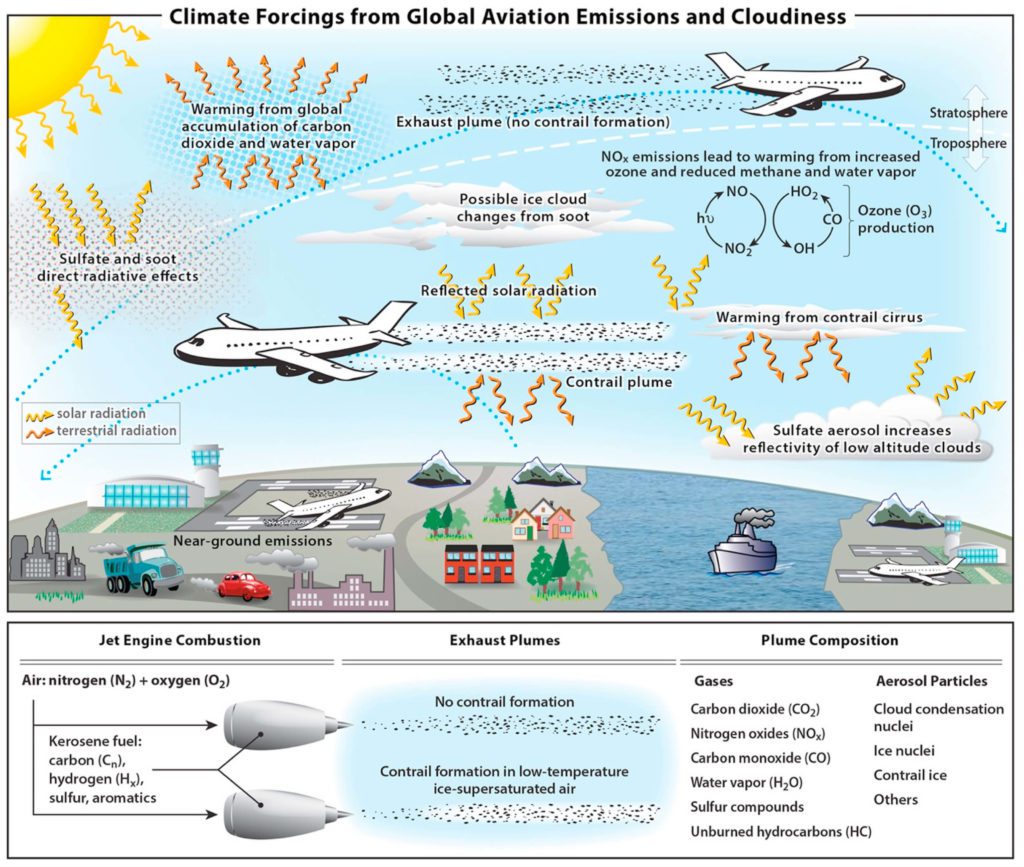Contrails: The Forgotten Lines
What are contrails and how much do they contribute to global emissions?
Once you start seeing contrails, you will not stop seeing them. Look up at the sky and there they are: white lines pushing airplanes across the blue expanse above to some unknown destination. When these mega ‘heavier-than-air’ vehicles reach a certain altitude (anywhere between 8-12 kilometers above ground) the ambient atmospheric air is cold enough to condense the water vapor and soot particles into artificial cirrus-like clouds that literally tail out behind the planes, tracing their trajectory across the sky. Criss-crossing lines and cross-hatching marks overlap to form a patchwork of fading knots. The contrails gradually disappear, leaving that ephemeral sensation of not having been. And yet, the polluting particles remain suspended up there invisible to the naked eye, slowly but surely contributing to the warming effect of planet Earth.
Contributing to global warming
According to the BBC, contrails are estimated to occur behind 18% of flights. And while they are ubiquitous, contrails (short for condensation trails) are not as innocuous as one might assume. In an exclusive interview, Magnus Gislev, Environment and Aviation Team Leader at the Mobility and Transport Directorate-General of the European Commission, described the nuances as follows:

Contrails are formed when water vapor is emitted from the aircraft and condenses on soot particles to form ice crystals, and this happens in socalled ‘ice super-saturated areas’ of the atmosphere.
The way this contributes to climate change is quite complex because actually in the morning and in the evening you have a cooling effect, and that is when the sun is low on the horizon, but then during the day when the sun is high up in the sky and also during the night there is a warming effect and this is because contrails actually reflect part of the solar radiation during the day but during the night they instead trap the heat and the infrared radiation, and stop it from disappearing from the Earth’s atmosphere.
The last scientific consideration which is important is that it’s quite easy to predict the short-lived contrails but much harder to predict with accuracy the so-called ‘persistent’ contrails, which can last in the sky anything from a few minutes up to several hours.
The longevity of the fake cloud formations depends on the humidity and temperature of the air. The drier and hotter the air, the quicker contrails dissipate. If the air is humid and cold, the ice clouds linger for longer. Contrails therefore contribute to climate change by trapping heat in the atmosphere. Increased cloudiness traps heat, and more persistent contrails have a greater warming impact.
Contrails contribute to climate change by trapping heat in the atmosphere
Of the net warming effective radiative forcing of aviation, contrails have the largest impact, followed by carbon dioxide and nitrogen oxide emissions. According to CNN, about 80-90% of the warming effects of contrails come from just 10% of flights traveling through extremely humid areas. Modifying flight paths and rerouting flights that produce high amounts of condensation trails could be one way to mitigate their impact. Other solutions are also emerging for the trendy and rather contradictory ‘sustainable’ aviation fuels (SAF).
Defining Contrails
“Contrail cirrus is an artificial cirrus-like cloud produced in the upper atmosphere (~ 8 to 12 km above ground) as a result of aircraft emissions of water vapor and soot particles into very cold atmospheres that are supersaturated with respect to ice. Conditions of the atmosphere (temperature and ice supersaturation) dictate whether linear contrails form behind the aircraft and persist to produce larger-scale spreading of the linear contrails into contrail cirrus.”
Source: European Commission, Report: Updated analysis of the non-CO2 climate impacts…

Can aviation fuels be sustainable?
Contrails are of course inextricably linked to the ever-controversial climate change topic – how exactly should we move people and products around the world, if not by flying? Do you really need to fly for your business trip or for your vacation? Why not take the train and join the slow-travel movement? Wouldn’t it be nicer to take your time getting from one point to the other.
Maybe next time I’ll take the train, you might think, but this time I just need to get there, no time to waste today. And so aviation and shipping remain major contributors to climate change, but the quest is on for sustainable solutions and the subsequent race has started to find those magic fuels that will make both aviation and shipping more sustainable.
Sustainable aviation fuels (SAF) are biofuels used to power aircrafts. They can come from a variety of renewable or waste sources, including:
- Corn grain
- Oil seeds
- Municipal solid waste
- Algae
- Other fats, greases and oils
- Agriculture and forestry residues
- Wet waste
- Mill waste
- Dedicated energy crops
Depending on the feedstock and production methods, they can have a significantly lower carbon footprint than conventional fuels. Made through a variety of processes including physical, chemical and biological reactions to break down biomass and turn it into energy-dense hydrocarbons for example, SAF can be chemically similar to traditional jet fuels. According to British Petroleum (BP), SAF can contribute to a reduction of up to 80% in carbon emissions over the lifecycle of a fuel compared to traditional jet fuels.
Greenwashing, some will say. Incumbent advantage, others will say. Those who crack the code of finding more sustainable fuels will control both of the massive global industries of aviation and shipping. So it is no surprise that Big Oil and Big Aviation are collaborating and competing to find the most sustainable solutions in order to maintain market share.
Algae was also seen as a major solution for providing more sustainable biofuels. In a best-case scenario estimation in Science Direct, up to 68% of GHG savings could be achieved with algae biofuels. Algae is only a preferable feedstock if certain conditions in cultivation and production are met, such as processing optimization, nutrient recycling, and the use of renewable energy in processing. Scalability is one of the biggest barriers to algae-based biofuels in aviation – necessary scale is likely 10-20 years away.

United Airlines invested $5 million in a company producing biofuels from algae as algae SAFs were expected to have a reduced carbon footprint of close to 70% and companies could maintain their competitive advantage and claim to be more ‘green’ than the others. There were testing ponds in the Emirates and millions were sunk in research labs, but as of 2023, ExxonMobil has ‘canned’ algae as a solution. All of the others involved in the race, such as the Big Aviation duopoly Airbus and Boeing are also turning away from algae. The funding necessary to substantially research and scale up algae fuel production is too large. No company has been willing to make the necessary investment. Gas is highly subsidized, which decreases the financial incentive to invest in algae. Wild algae strains do not produce enough lipids and genetically modified strains are necessary but difficult to extract.
Aviation Emissions
Global aviation (passenger and freight) contributes to a few percentiles of global greenhouse gas (GHG) emissions, including CO2, and contribute 3.5% of effective ‘radiative forcing’ (overall warming). Flying accounts for around 2.5% of global CO2 emissions, but 3.5% when we take nonCO2 impacts on climate into account. Contrails account for the largest share of nonCO2 warming, about 2/3 in total.
Sources: Our World in Data, Elsevier Science Direct
Etihad Airways has ambitious targets to become the first airline to reach net zero emissions by 2050 and reduce emissions by 50% by 2035. Etihad is already blending fuels with SAF and is positioning itself as an aviation market leader in moving towards 100% SAF flights. According to Air Insight, Airbus is developing a hydrogen-powered aircraft and advancing its hydrogen strategy. Boeing is exploring more ideas too and has a well-developed strategy. Marc Allen, Boeing’s chief strategy officer at NBAA-BACE 2002 says:
“We have shifted our language from zero emissions to zero impact. Hydrogen might have a role, but that might be being used on the ground to produce SAF or perhaps for direct propulsion. But how can we be sure it’s truly green hydrogen and that the net result might not be worse in terms of emissions, not just CO2 but also contrails.”

There is no holy grail for sustainable aviation fuels. Meanwhile the quest for reducing emissions continues and reveals complex layers of questions revolving around how we can continue to race around the world (more sustainably somehow) in these amazing gravity-defying vessels.
According to Magnus Gislev from the European Commission, for contrails and climate change the conclusion is that “if you reduce the number of soot particles and the amount of sulfur dioxide that you emit, you can also reduce the formation of contrails.” Combining more renewables with planet-conscious choices is the first step. It may remove the ever-changing patchwork of clouds above us, but it can make our travel more sustainable.